Optics Expansion Kit User Manual
Order Code: OEK
The Vernier Optics Expansion Kit (OEK) is a set of lenses, a light source, a sensor holder, an aperture plate, and a screen for use with a Vernier dynamics track. The required track is available separately (order code: TRACK) or as a part of our Dynamics Cart and Track Systems. Students can perform basic optics experiments with this equipment. Some typical experiments done with the system include
- Thin lens image formation from a converging lens
- Thin lens equation
- Image formation by a convex lens
- Focal length measurement
- Simple telescope construction
- Microscope
- Inverse-square law of light intensity from a point source
- Lens diameter and shape effects on image
The OEK supports the addition of a Go Direct® Light and Color (order code: GDX-LC) or a Vernier Light Sensor (order code: LS-BTA).
For platform-specific connection information for use with Go Direct Light and Color, see www.vernier.com/start/gdx-lc
For platform-specific connection information for use with the Vernier Light Sensor, see www.vernier.com/start/ls-bta
Note: Vernier products are designed for educational use. Our products are not designed nor are they recommended for any industrial, medical, or commercial process such as life support, patient diagnosis, control of a manufacturing process, or industrial testing of any kind.
What's Included
- Light source with power supply
- Screen
- Light sensor holder
- Aperture disc
- 100 mm focal length double convex lens
- 200 mm focal length double convex lens
- –150 mm focal length double concave lens
Compatible Software
Sample Experiments
Real Image Formation
The thin lens and linear magnification equations (shown below), can be verified using the OEK.
Place the light source near the end of the track, with the luminous source facing along the longer length of the track. Insert the 100 mm focal length lens into a holder, and place it 15 cm from the light source plane. Place the screen on the side of the lens opposite the light source. Where do you find a sharp image? Is it where you expect it using the thin lens equation
Measure the height of the image and object. Does the linear magnification you observe match the prediction?
Inverse Square Law
Position the light source so that the LED is exposed and is facing down the length of the track. Read the position using the back edge of the carriage for the light source. Attach a light sensor to the light sensor holder. For instructions on mounting your light sensor in the holder, see www.vernier.com/manuals/lshb-oek. The location of the sensor can then be read from the arrows on the holder. Position the sensor so it is pointing directly at the light source. Allow the light source to stabilize for 15 minutes before collecting data. The intensity falls slightly as the LED warms, so for this experiment, warm-up time is required. Note: the room should be partially darkened during data collection.
Collect intensity data as a function of distance. Does the light intensity follow the expected inverse-square relationship? Graph light intensity vs. the inverse of the squared distances. Is the resulting graph a direct proportionality?
Additional Optics Experiments (some accessories not included)
- Make a telescope by combining convex lenses at the sum of focal lengths.
- Study the effect of lens size and shape on image formation. Set up the luminous source, a converging lens, and the screen so that you see a real image on the screen. Position the aperture plate as close to a lens as possible, and observe the effect of different size apertures. You may need to dim the room lights to see the changes. What will happen with the D-shaped opening?
- Study depth-of-field by casting a real image of the two slits on the screen, and then take it out of focus by moving the screen until you can no longer resolve the two lines. Use the aperture plate to make the working diameter of the lens smaller. How does this change the image?
- Investigate color mixing by comparing the relative contributions of the red, green and blue LEDs from the Color Mixer Kit (order code: CM-OEK) to create various colors.
- Study image formation with mirrors using the Mirror Set (order code M-OEK).
- Investigate the polarization of light using the Polarizer/Analyzer Kit (order code: PAK-OEK). You can use a rotary motion sensor to record analyzer angle making Malus’s law experiments easy, detailed, and accurate.
- Study diffraction and interference patterns using the Diffraction Apparatus (order code: DAK). (LabQuest 3 or LabQuest Mini sensor interface also required.)
How the Sensor Works
Common Holder Design
The OEK components all use similar plastic holders. These holders snap to the track with a slight pull to the side. The base unit has fiducial marks to locate the center line of a screen, sensor, light or lens held by the base. Read the scale on the track through the hole in the base unit.
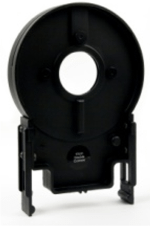
Lenses
The lenses are permanently mounted in their holders. Do not remove the lenses.
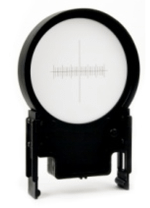
Screen Assembly
The screen is marked with a millimeter scale.
Light Source Assembly
The light source uses a single white LED. A rotating plate lets you choose various types of light for experiments. The open hole exposes the LED to act as a point source. The other openings are covered by white plastic to create luminous sources. The figure “4” is for studying image formation, and is chosen since it is not symmetric left-right or up-down. The “L” shape is 1 by 2 cm in size. The double-slit is used for depth-of-field experiments.
The plane of the luminous sources is located at the position marked by the pointer on the base. In contrast, the LED point source is located at the back edge of the holder. This location is important to note for accurate distances in inverse-square experiments.
The power supply provided with the OEK is the same as the power supply for LabQuest 3. A rocker switch on the back of the light source turns the light on and off.
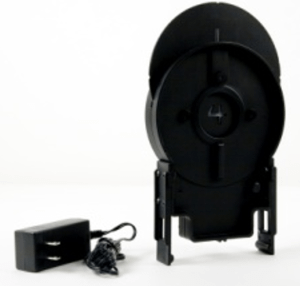
Light Sensor Holder
The light sensor holder is used to position a Go Direct Light and Color or Vernier Light Sensor aligned with the light source’s LED. Attach the sensor cradle if you are using the Go Direct Light and Color Sensor. Use the pegs on the right side (when facing the light source) of the base when using the light sensor. Use the left pegs if you are investigating color. When using a Vernier Light Sensor, attach the Vernier Light Sensor holder using the thumb screws and insert sensor until it reaches the stop. In either case, the location of the sensor can then be read from the arrows on the base of the holder. For additional assembly instructions, see www.vernier.com/manuals/lshb-oek
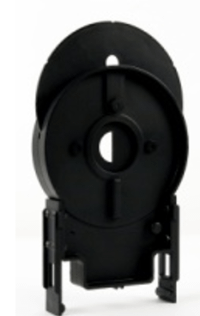
Aperture Disc
The aperture disc can be placed immediately adjacent to a lens in order to vary the effective diameter and shape of the lens. Experiments regarding f/stop and brightness can thus be performed. A D-shaped aperture allows the “half a lens” demonstration to be performed.
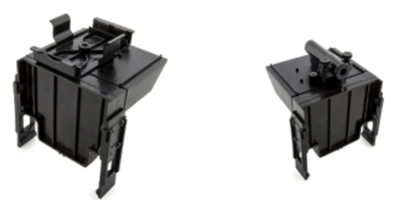
Troubleshooting
For troubleshooting and FAQs, see www.vernier.com/til/2948
Accessories/Replacements
| Accessory | Order Code |
|---|---|
|
TRACK |
|
|
TRACK-LONG |
|
|
M-OEK |
|
|
DAK |
|
|
PAK-OEK |
|
|
CM-OEK |
| Replacement | Order Code |
| Replacement Aperture Assembly for OEK |
APT-OEK |
| Replacement 10 cm Converging Lens for OEK |
L10B-OEK |
| Replacement 15 cm Diverging Lens for OEK |
L15B-OEK |
| Replacement 20 cm Converging Lens for OEK |
L20B-OEK |
| Replacement Light Source for OEK |
LSB-OEK |
| Replacement Light Sensor Holder Bracket for OEK |
LSHB-OEK |
| Replacement Screen for OEK |
SCRN-OEK |
| LabQuest Power Supply |
LQ3-PS |
| Pulley Bracket |
B-SPA |
Warranty
Warranty information for this product can be found on the Support tab at www.vernier.com/oek/#support
General warranty information can be found at www.vernier.com/warranty
Contact Support
Fill out our online support form or call us toll-free at 1-888-837-6437.

